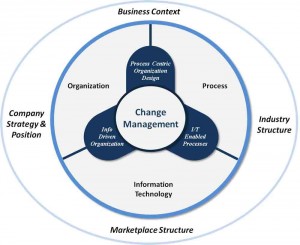Business Process Re-engineering

What is Business Process Re-engineering?
Business Process Re-engineering (BPR) involves rethinking and adapting business processes to achieve higher productivity and increase competitiveness.
Why BPR?
With the advent of new technologies, companies are facing the reality that “their processes are outdated and slow”. They are reaching a point where they must choose to “re-engineer”. For these businesses, BPR success is critical. BPR seeks to help companies radically restructure their organizations by focusing on the ground-up design of their business processes.
According to Davenport, a business process is a set of logically related tasks performed to achieve a defined business outcome. Re-engineering emphasized a holistic focus on business objectives and how processes related to them, encouraging full-scale recreation of processes rather than iterative optimization of sub processes.
BPR success factors
Generally, BPR does not only mean change, but rather dramatic change. The drastic change may affect the organizational structures, management systems, employee responsibilities and performance measurements, incentive systems, skills development and the use of IT. Hence BPR can impact every aspect of how a business is conducted. This change can cause results ranging from enviable success to complete failure.
Successful BPR can result in enormous reductions in cost or cycle time. It can also potentially create substantial improvements in business operations, quality, customer service, or other business objectives. Re-engineering can help an aggressive company to stay on top, or transform an organization on the verge of bankruptcy into an effective competitor. Some important success factors were identified as essential to the success of a BPR activity are discussed below.
BPR team composition
A BPR team must be selected once an organization-wide commitment has been secured from all departments involved in the re-engineering effort. This team will form the nucleus of the BPR effort. They would make key decisions and recommendations, and help to communicate the details and benefits of the BPR program to the entire organization.
The members of the team are also selected based on certain factors and qualities which the organization think is inevitable. The most effective BPR teams include active representatives from the following work groups: top management, business area responsible for the process being addressed, technology groups, finance, and members of all ultimate process users’ groups. Team members who are selected from each work group within the organization will have an impact on the outcome of the reengineered process according to their desired requirements. The BPR team should be mixed in depth and knowledge.
Business needs analysis
Once the team is formed a thorough business needs analysis must be conducted. The BPR teams must first assess the current processes of the organization and determine what exactly needs to be reengineered. In this analysis phase, a series of sessions should be held with process owners and stakeholders, regarding the need and strategy for BPR. These sessions helps to identify the vision of the ideal business process. They also help identify essential goals for BPR within each department and then collectively define objectives for how the project will impact each work group or department on individual basis and the business organization as a whole.
A successful business needs analysis would help in relating the BPR project goals back to key business objectives and the overall strategic direction for the organization. This connection should show the thread from the top to the bottom of the organization, so that each person can easily relate the overall business direction with the re-engineering effort.
BPR projects that are not in alignment with the organization’s strategic direction can be counterproductive. These initiatives are wasteful and steal resources from other strategic projects. So, the business needs analysis is important in the process as it contributes tremendously to the re-engineering effort by helping the BPR team to prioritize and determine where it should focus its improvements efforts.
Need of IT infrastructure
An adequate IT infrastructure reassessment and composition is a vital factor for a successful BPR implementation. This includes building an effective IT infrastructure, effective alignment of IT infrastructure and BPR strategy, proper information systems (IS) integration, increasing IT function competency, and effective use of software tools are the most important factors that contribute to the success of BPR projects. An IT infrastructure is made up of physical assets, intellectual assets, shared services, and their linkages. The way in which the IT infrastructure components are composed and their linkages determines the extent to which information resources can be delivered.
Linkages between the IT infrastructure components, as well as descriptions of their contexts of interaction, are important for ensuring integrity and consistency among the IT infrastructure components. The IT infrastructure shared services and the human IT infrastructure components are both vital to the process of the IT infrastructure composition. The IT infrastructure and BPR are interdependent because deciding the information requirements for the new business processes determines the IT infrastructure constituents, and a recognition of IT capabilities provides alternatives for BPR. Hence building a responsive IT infrastructure is highly dependent on an appropriate determination of business process information needs which in turn is determined by the types of activities embedded in a business process, and their sequencing and reliance on other organizational processes.
Effective change management
Change management is considered by many researchers to be a crucial component of any BPR effort. This involves all human and social related changes and cultural adjustment techniques needed by management to facilitate the insertion of newly designed processes and structures into working practice and to deal effectively with resistance. Most projects do not achieve the full potential of their change effort as they tend to underestimate the cultural impact of major process and structural change. Many people fail to understand that change is a management technique.
An important step towards any successful reengineering effort is to convey an understanding of the necessity for change. Implementing BPR successfully is dependent on how thoroughly management conveys the new cultural messages to the organization. These messages provide people in the organization with a guideline to predict the outcome of acceptable behavior patterns. People should be the focus for any successful business change.
BPR failure factors
BPR initiatives have been unsuccessful because organizations decide to implement an initiative that isn’t necessary. BPR requires a large financial and time commitment. The investment must be worth the input. Before moving forward with major change, organizations must make certain they have great cause – the company should re-engineer because of a need to adapt their processes in order to prevent failure or to enable competitive advantage.
On the other hand, BPR projects can fail to meet the inherently high expectations of reengineering. Many unsuccessful BPR attempts may have been due to the confusion surrounding BPR, and how it should be performed. Organizations were well aware that changes needed to be made, but did not know which areas to change or how to change them. As a result, process reengineering is a management concept that has been formed by trial and error i.e. practical experience. As more and more businesses reengineer their processes, knowledge of what caused the successes or failures is becoming apparent. To keep lasting benefits, companies must be willing to examine how strategy and reengineering complement each other by learning to quantify strategy in terms of cost, milestones, and timetables, by accepting ownership of the strategy throughout the organization, by assessing the organization’s current capabilities and process realistically, and by linking strategy to the budgeting process. Otherwise, BPR is only a short-term efficiency exercise.
Misuse of IT is a common cause of BPR failure. IT is a key component of enabling the new processes. IT tools enable companies to streamline their processes, access key reports and data, and reduce inefficiencies. However, organizations often fail because they don’t have the expertise to select the proper tools and implement them. Companies should utilize experts to aid in tool selection and implementation. They must learn how to use the tool and clearly define the role of the tool in the new process. IT tools are only useful if they are utilized. The success of new processes will likely hinge on the tools selected.
Why BPR should be an ongoing process?
BPR is a successive and ongoing process and should be regarded as an improvement strategy that enables an organization to make the move from traditional functional orientation to one that aligns with strategic business processes. Continuous improvement is defined as the propensity of the organization to pursue incremental and innovative improvements in its processes, products, and services.
The incremental change is governed by the knowledge gained from each previous change cycle. To ensure that the process generates the desired benefits, it must be tested before it is deployed to the end users. If it does not perform satisfactorily, more time should be taken to modify the process until it does. A fundamental concept for quality practitioners is the use of feedback loops at every step of the process and an environment that encourages constant evaluation of results and individual efforts to improve. Anticipating and planning for risk handling is important for dealing effectively with any risk when it first occurs and as early as possible in the BPR process.
Source: https://en.wikipedia.org/wiki/Business_process_reengineering
https://www.techopedia.com/definition/13764/business-process-re-engineering-bpr

